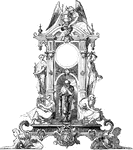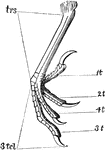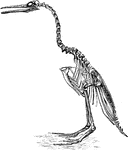
The Restoration of the Hesperornis Regalis
"Hesperornis regalis, (a fossilized restoration) which stood about three feet high, had blunt teeth…

Skeleton Head of a Ichthyornis
"Ichthyornis victor and I. dispar, ...were small forms of about the size of a Partridge, with the habits…
Oat
The common oat (Avena sativa) is a species of cereal grain grown for its seed. While oats are suitable…

Flatworm
Flatworms are flattened, leaf-like forms living in damp places on land, in freshwater streams of ponds,…

Earthworm Anatomy
The earthworms are also known as megadriles, in the families Tubificidae, Lumbriculidae, and Enchytraeidae.…
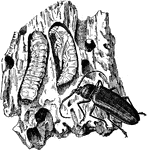
Beetle
Beetles are the group of insects with the largest number of known species. The general anatomy of beetles…

Bezants Figured
"Gules, three bezants figured. FIGURED. Those bearings which are depicted with a human face, are said…
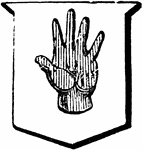
Knight and Baronet of King James I
"KNIGHT AND BARONET. A degree of honour next to a baron, created by King James I. to induce the English…
the Windpipe of a Male Red Breasted Merganser
"Trachea or windpipe of the red breasted merganser, Mergus serrator, about half natural size, viewed…
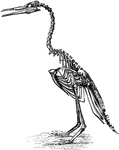
Restoration of Hesperornis regalis
"Hesperornis regalis, (a fossilized restoration) which stood about three feet high, had blunt teeth…
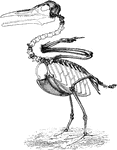
Restoration of Ichthyornis
"Ichthyornis, though the wings are well developed, with fused metacarpals, and the sternum is keeled,…
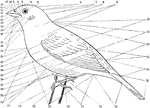
Topography of a Bird
"fig. 25 - Topography of a Bird. 1, forehead (frons). 2, lore. 3, circumocular region. 4, crown (vertex).…
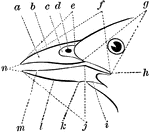
The Parts of a Bird Bill
"Fig. 26 - Parts of a Bill. a, side of upper mandible; b, culmen; c, nasal fossa; d, nostril; e(see…
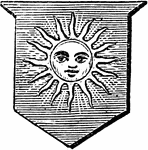
Sun in its Splendor
"Azure, a sun in its splendour. SOL, or THE SUN IN ITS SPLENDOUR. The sun is said to be in its splendour…
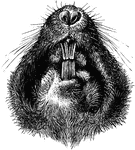
Plains Pocket Gopher
"Under Side of Head of Geomys bursarius, showing entrance of external cheek-pouches and sulcate superior…
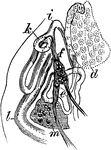
Reproductive Organs of Trematoid Worm
"Reproductive Organs of a Trematoid Worm (Aspidogaster conchicola). d, germarium; e, internal vas deferens;…

Parts of Fish Gills
"Gill of Fish. A, first branchial arch of left side of black-bass: 1, gill-rakers; 2, branchial lamellae.…
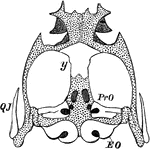
Frog Chondrocranium
"Chondrocranium of Frog (Rana esculenta). y, girdle-bone or os en ceinture; EO, exoccipital; PrO, proötic;…
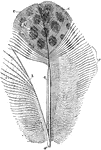
Feather from a Argus Pheasant
"Fig. 19 - A partly pennaceous, partly plumulaceous feather, from Argus pheasant; after Nitzsch. ad,…

Structure of a Feather
"Fig. - 20 - Two barbs, a, a, of a vane, bearing anterior, b, b, and posterior, c, barbules; enlarged;…
Single Barbule
"Fig. 21. -A single barbule, baring barbicels and hooklets; magnified; after Nitzsch. ...barbicels (another…

Barbs
"The arrangement shown in fig. 22, where a, a, a, a, are four barbs in transverse section, viewed from…
A Feather from the Tail of a Kingbird
"Fig. 23 - A feather from the tail of a kingbird, Tyrannus carolinensis, almost entirely pennaceous;…

Pterylosis of Cypselus Apus
"Fig. 24. - Pterylosis of Cyoselus apus, drawn by Coues after Nitzsch; right hand upper, left hand lower,…

The Bones of the Right Wing of a Duck
"Fig 27. - Bones of the right wing of a duck, Clangula islandica, A, shoulder, omos; B, elbow, ancon;…
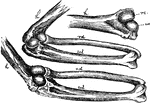
Mechanism of the Elbow-Joint
"Fig. 28. - Mechanism of elbow-joint. ..., where rc and uc show respectively the size, shape, and position…

The Wing Bones of a Young Grouse
"Fig. 29., from a young grouse (Centrocercus urophasianus, six months old), is designed to show the…
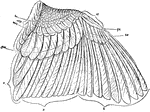
Feathers of a Sparrow's Wing
"Fig. 30., Feathers of a sparrow's wing. pc, covers of the primaries; msc, median upper secondary coverts;…
Red Shafted Woodpecker Ulna
"Fig. 31. - Ulna of Colaptes mexicanus, showing points of attachment of the secondaries. (Dr. R. W.…

Bird Skulls
"Fig. 114. -Skulls of Turdidae and Sylvicolidae, nat. size; after Shufeldt. A, Oroscoptes montanus;…
Margin Drawing
This margin drawing was created by German artist Albrecht Dürer in 1515. It is found in the prayer…
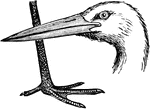
Stork Head and Leg
The head and leg of the stork, a bird in the Ciconiidae family of storks, herons, and egrets.

Rabbit Brain
"Brain of rabbit. Ol, olfactory lobe; A, B, C, frontal, occipital, and temporal lobes; Sy, Sylvian fissure."…

Pig Brain
"Brain of pig. Ol, olfactory lobe; A, B, C, frontal, occipital, and temporal lobes; C1, a portion of…

Chimpanzee Brain
"Brain of chimpanzee. Ol, olfactory lobe; A, B, C, frontal, occipital, and temporal lobes; C1, a portion…
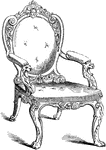
Chair
This chair has a simple scroll design around the edges. It has animal heads on the front ends of the…

Cabinet
This cabinet is carved in oak by using a method of burning wood into a desired pattern. The ornamental…
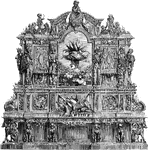
Sideboard
This sideboard is carved in walnut wood in a French Renaissance style. It is richly decorated with human…

Vase
This vase is a maltese design that stands on a pedestal with an unusual design of large bird in the…

Flower Stand with Vase
This flower stand with vase is a maltese design. The stand has a simple leaf design with a base that…

Flower Stand
This flower stand has a design on its column of two birds with lowered heads. The top is richly decorated…

Jug
This jug stands on a pedestal. It has a leaf design on its base, and human figures encircling the top.…
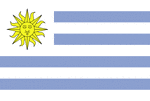
Flag of Uruguay, 2009
Color flag of Uruguay. Nine equal horizontal stripes of white (top and bottom) alternating with blue;…
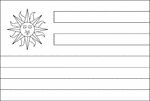
Flag of Uruguay, 2009
Black and white outline flag of Uruguay. Nine equal horizontal stripes of white (top and bottom) alternating…

Scutellate Laminiplanter Tarsus of a Cat-bird
"Figure shows Scutellate laminiplanter tarsus of a cat-bird. A tarsus so disposed as to its podotheca…
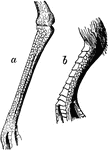
Reticulate Tarsus of a Plover
"Fig 38 a, Reticulate tarsus of a Plover. b, Scutellate and reticulate tarsus of a pigeon." Elliot Coues,…
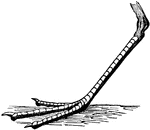
Tridactyle Foot of a Sanderling
"Fig. 39 shows a Tridactyle foot of a sanderling, Calidris arenaria." Elliot Coues, 1884
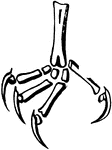
Phalanges of Cypseline Foot
"Fig. 40 Phalanges of Cypseline foot, where the ratio is 2, 3, 3, 3 of Caprimulginae." Elliot Coues,…

Phalanges of Caprimulgine
"Fig. 41 shows phalanges of caprimulgines foot, where the ratio is 2, 3, 4, 4." Elliot Coues, 1884
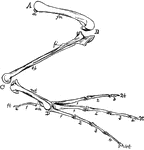
Bones of a Bird's Hind Limb
"Fig 34 - Bones of a bird's hind limb: from a duck, Clangula islandica. A, hip: B, knee: C, heel or…

Typical Passerine Bird Feet
"Fig. Typical passerine feet. The right hand fig. is plectrophanes lapponicus." Elliot Coues, 1884

The foot of a Kingfisher
"Fig. 44- Syndactyle foot of a kingfisher. Thus a kingfisher shows what is called a syndactyle or syngnesious…

Zygodactyle Foot of a Woodpecker
"Fig. 45.- Zygodactyle foot of a woodpecker, Hylotomus pileatus. The zygodactyle or yoke-toed modification…

The Raptorial Foot of a Hawk
"Fig. 46. - Raptorial foot of a hawk, Accipiter cooperi. The raptorial is another modification of the…

The Raptorial Foot of an Owl
"Fig. 47. - Raptorial foot of an owl, The raptorial is another modification of the insessorial foot.…


